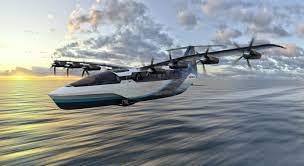Regent’s Electric Seagliders: Revolutionizing Water Travel in Japan
Introduction
The future of transportation is being reshaped by technological advancements, and Regent is at the forefront of this revolution. The company’s electric seagliders are set to transform water travel in Japan, offering a sustainable and efficient mode of transportation. In this article, we will explore the innovative features of Regent’s seagliders, their potential impact on the waterways of Japan, and the benefits they bring to passengers and the environment.
The Rise of Electric Seagliders
A New Era of Sustainable Transportation
Electric seagliders represent a breakthrough in sustainable transportation. By harnessing the power of electricity, these innovative vessels offer a clean and efficient alternative to traditional watercraft. With zero emissions and reduced noise pollution, electric seagliders align with the global push for greener transportation solutions.
Regent’s Vision for Electric Seagliders
Regent, a pioneering company in the field of electric seagliders, aims to revolutionize water travel in Japan. Their vision is to create a network of electric seaglider routes, connecting major cities and islands, and providing commuters and tourists with a fast, reliable, and eco-friendly mode of transportation.
The Technology Behind Regent’s Seagliders
Electric Propulsion Systems
Regent’s seagliders are powered by advanced electric propulsion systems, which utilize electric motors and batteries to drive the vessels forward. These systems are highly efficient, converting electrical energy into mechanical energy with minimal losses. By eliminating the need for fossil fuels, Regent’s seagliders significantly reduce carbon emissions and dependence on non-renewable resources.
Hydrofoil Design
One key feature of Regent’s seagliders is their hydrofoil design. Hydrofoils are wing-like structures mounted beneath the hull, lifting the vessel above the water’s surface as it gains speed. This design reduces drag and increases efficiency, allowing the seagliders to glide smoothly and swiftly over the water.
Battery Technology
To power the electric propulsion systems, Regent’s seagliders rely on advanced battery technology. These high-capacity batteries store the required electrical energy and provide the vessels with the necessary power for extended journeys. With continuous advancements in battery technology, the range and endurance of electric seagliders are constantly improving.
The Benefits of Electric Seagliders
Environmental Sustainability
One of the primary benefits of Regent’s electric seagliders is their positive environmental impact. By using clean energy sources, these vessels produce zero emissions, helping to reduce air pollution and combat climate change. Additionally, their electric propulsion systems generate less noise pollution, minimizing disturbance to marine life and waterfront communities.
Increased Efficiency and Speed
Electric seagliders offer a more efficient and faster mode of transportation compared to conventional watercraft. The hydrofoil design reduces drag, allowing the vessels to achieve higher speeds with less power consumption. Passengers can enjoy shorter travel times, making electric seagliders an attractive option for both commuters and tourists.
Improved Connectivity
Regent’s vision for a network of electric seaglider routes in Japan aims to enhance connectivity between cities, islands, and coastal regions. This improved connectivity opens up new opportunities for economic growth, tourism, and cultural exchange. By providing a reliable and efficient transportation option, electric seagliders can bring communities closer together.
Reduced Traffic Congestion
Waterways often face congestion due to heavy traffic from ferries, boats, and other watercraft. Electric seagliders can help alleviate this congestion by offering an alternative mode of transportation. With their ability to travel swiftly and efficiently, seagliders can reduce the pressure on existing water transport infrastructure and contribute to smoother traffic flow.
The Potential Impact on Japan’s Waterways
Connecting Coastal Cities and Islands
Japan is known for its extensive coastline and numerous islands. Regent’s electric seagliders have the potential to transform water travel in Japan by connecting coastal cities and islands that are currently difficult to access. This increased connectivity can boost tourism, facilitate economic development, and improve the quality of life for residents in these areas.
Reducing Reliance on Air and Road Travel
Air and road travel are the most common modes of transportation in Japan. However, these modes often face challenges such as congestion, limited capacity, and environmental concerns. Electric seagliders provide a viable alternative, offering a sustainable and efficient means of travel that can reduce the strain on other transportation systems.
Enhancing Tourism and Recreation
Japan attracts millions of tourists each year, drawn to its rich cultural heritage, stunning landscapes, and vibrant cities. Electric seagliders can enhance the tourism experience by providing scenic and eco-friendly transportation options. Tourists can explore coastal areas, visit remote islands, and enjoy breathtaking views during their journeys on these innovative vessels.
Conclusion
Regent’s electric seagliders are poised to revolutionize water travel in Japan. With their sustainable and efficient design, these vessels offer numerous benefits to passengers, the environment, and the overall transportation infrastructure. As Regent continues to innovate and expand its network, the waterways of Japan will be transformed, providing a greener and more connected future for all.



